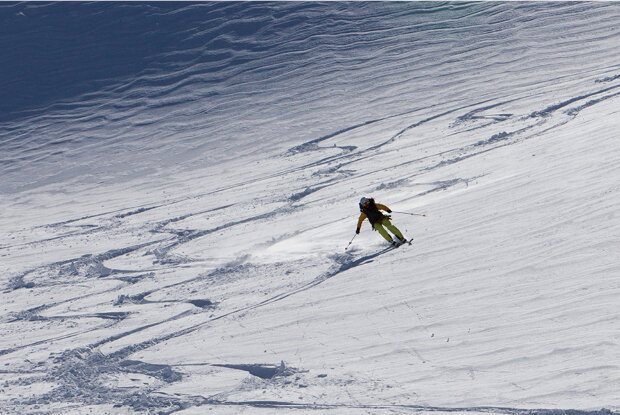SUMMER SHRED MISSIONS IN THE CANADIAN ROCKIES
By Abby Cooper
Without a winter to brag about, many of us have this lingering feeling that winter is still just around the corner. Hate to break it to you friends, but she’s gone. At least until next season, which, fingers crossed, will be a doozy. Until then, contributor Abby Cooper brings us her best suggestions for summer stashes in the Canadian Rockies.
There may not be an ounce of snow in the forecast, but that doesn’t mean we can’t squeak in a line or two over the next couple of months to tide us over for winter. A warning in advance, however: these summer shred missions are not for the faint of heart! You must be a skilled mountaineer with a whole lot of determination, a sense of adventure and, of course, the snow smarts to make the right call. Let’s not forget about the right tools and gear, as well as the back strength to carry them up some of these lengthy ascents.
We can’t guarantee the snow conditions or safety of any of these skiable summer locations, but we can give you the advice on how to get there. If you just can’t curb your craving for snow, venture out in the backcountry to one of these shred-able summer spots and get some snow under those planks!
PARKER RIDGE / HILDA RIDGE
Banff National Park (* Intermediate Summer Skiing)
A quick 104-km drive north of Lake Louise will bring you to one of the most reliable summer skiing locations in the area, Parker Ridge. With a starting elevation just shy of 1900m, it is a quick elevation gain by foot to get on top of some skiable terrain. To the top of the ridge it is only 300m by foot on a well-defined trail.
You most likely will not be skinning before your first descent, but don’t go without touring gear. Parker Ridge is a rare area that can tackled with skis all the way through July and August (season dependent, of course). This is a summer favourite for the quick access time and reliable amount of snow. Note: reliable amount of snow, not reliable snowpack. Be careful out there!
Access:
Park at the Hilda Ridge Parking lot, which provides the quickest access for skiing. You will need to cross the highway and start walking on an old road that leads to up to the Hilda Creek Hostel. Before you near the hostel you will quickly see an obvious trail going up towards Hilda and Parker Ridge, away from the highway. Most of your elevation gain will happen rapidly and before you know it you will be on top of a line. Most of the snow on Parker sits on top of a loose rock surface, so keep that in mind while you are accessing the snowpack, and as weather changes.
Bring:
Be sure to bring your touring kit, first aid gear, tools, avalanche gear and your shredding stoke. Worst-case scenario: you’ll have knocked out an incredible hike with a view, even if the snow isn’t cooperating to ski down.
Route Planning. Photo by Abby Dell Photography
RAE GLACIER
Peter Lougheed Provincial Park (* Intermediate)
Short and steep, the Rae Glacier is quickly disappearing, but the evidence of its once big presence is clear from the cradle carved in the mountain walls. While the skiing may not be long or overly complex, it’s a relatively quick and rewarding trek with skiing in the summer (that alone is brag-worthy). Highway 40 leads the way to Rae Glacier, meaning it is only open June through November. This gem can usually be skied into September, but the earlier the better for snow conditions. On route you will pass through the very popular Elbow Lake, which allows for camping if you care to make this into a multi-day trip.
Access:
Starting from the Elbow Pass day area, head towards Elbow Lake, a short 1.5km on a wide, well-maintained trail. Pass through the camping area and stick to the South side of the lake heading East until you reach a creek. From there it is only 2.5km and 400m until you are at the toe of Rae Glacier. The trail will hug the creek, until the creek veers a hard left. Continue straight and stay right to ascend.
Bring:
Although Rae Glacier is not littered with danger, it still involves glacier travel, so be sure to bring all the necessary gear. Because it is a relatively short haul, it might be fun to camp for the night if your back can afford camping gear on top of your regular glacier travel gear, avalanche gear, touring gear and first aid supplies.
ROBERTSON GLACIER
Peter Lougheed Provincial Park (** Advanced Ski Mountaineering)
One of the classic summer ski trips a bit closer to the Banff hub is Robertson Glacier. This smooth glacier has few crevasse and terrain traps, although glacier travel and protocol is still required. Only head here on a day with good visibility, as entering and exiting the ice can be a tricky transition. What we love about it is the proximity and the lengthy runs. We also love that the approach exposes much of the glacier so you can really plan out your ascent and descent.
There is also the Robertson Col, which can be accessed as you make the climb up. If you ski tour regularly in the area you’re probably familiar with its neighbour, Burstall Pass, so you’ll recognize the parking lot and part of the trail. Head up to Robertson Glacier until August after a strong winter season. Its prime time is July.
Access:
The parking lot is located 45km south of Canmore on the Smith-Dorrien Trail. Start on the trail towards Burstall Pass for the first 4km, which will cruise by as it is relatively flat. You will soon stumble upon a logging road, and eventually a BCA Beacon Basin training park. Keep on going. From here there is a steep 75-metre section to continue on the logging road. After 2.5km you will have visibility of the Robertson Glacier. Turn left (South) towards the glacier.
Bring:
The 900m elevation gain requires glacier tools, such as harness, rope, ice axe, crampons, touring gear, first aid gear, avalanche gear and ice knowledge with strong skiing
Left: Glacier Travel. Photo by Abby Dell Photography / Right: Sierra staying stoked on the Rae Glacier. Photo by Abby Dell Photography
AEMMER COULOIR, MT. TEMPLE
Banff National Park (*** Experts only)
The Aemmer Couloir is for the most skilled ski mountaineers only. This year-round couloir is no joke, with a 12km approach to the base of the 45-degree, 600m couloir. You will, without a doubt, need ice axes and crampons. You must be physically prepared, extremely knowledgeable in mountaineering, possess the right tools and have the right snow conditions to even dream of taking this on.
So why are we talking about it? Because it is something to work towards. This is one of the most-talked-about Canadian couloirs out there, and there is a reason. The single white line dashing from head to toe (almost) on the stunning Mt. Temple is any skier’s dream.
Access:
In the summer months you will be able to start from the Paradise Valley parking lot off of the Moraine Lake Road. The roughly 12km approach to the moraines and bouldered area below the couloir is a long one, but once there it is all about getting creative and playing it safe to reach the top. Couloirs are terrain traps; keep that in mind when planning your route. The Aemmer offers some of the most heart-pumping skiing available in our region, but it is also a high risk for a high reward.
Bring:
If you are heading here in the summer, no touring gear is required, just ski mountaineering equipment, first aid, and avalanche gear.
A NOTE FROM WILDLY: You, the reader, are responsible for your own safety and gathering all the information you require to tackle these summer stashes! We cannot be held responsible should you choose to venture out in search of these snow patches and glaciers. Please adventure safely, and use these suggestions as just that: suggestions.
A lover of all things outdoors, Abby Cooper is a splitboarder, climber, hiker, adventurer, photographer and writer. She’s living life one adventure to the next with her dog by her side.



